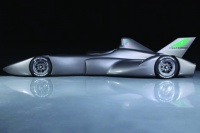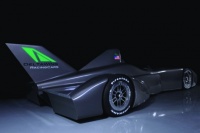
Motorsport is struggling with two big problems. The gas-guzzling, high-carbon image of motor racing goes against current thinking, with the 21st century increasingly becoming an era where the environment tops the agenda. Meanwhile, and even more pressingly for the business people behind the sport, audiences are falling away as the lack of action-packed wheel-to-wheel racing threatens to turn events into tedious processions. Could the answer to both problems be a car that looks like a cross between a fighter jet and the Batmobile?
With its roots firmly in British motorsport design, the striking DeltaWing racer, developed as a concept for American IndyCar racing, has raised more than a few eyebrows in the motorsport community since it was unveiled last year. Its developers claim that the radical design could be the saviour of motorsport and the concept, although controversial, is making waves in the international motor-racing circuit.
Developed by Chip Ganassi Racing for the IZOD IndyCar series, the DeltaWing was designed as an alternative to the current fixed-specification Dallara chassis. The aim was to dramatically improve the sustainable credentials of racing while, at the same time, increasing overtaking and reigniting the fast-disappearing interest in the sport.

’When most cars go around a corner they turn out to be a three-wheel car at the limit of grip anyway,’ said Bowlby. ’Using this design actually worked out very beautifully, and to our great surprise and satisfaction, the car immediately hit its targets in simulation. We were able to be absolutely faster than the current cars, if not faster, and we would burn less than half the fuel.’
But going faster in a lighter vehicle caused its own problems. The consequence of injury to the driver in the event of a crash was a major concern. According to Dr John Melvin, who helped bring in safety features to NASCAR, if a driver is properly restrained in a vehicle they can walk away from a 150G peak impact. Heeding this advice, DeltaWing engineers improved seat restraints, increased the crushable structure at the front of the car and looked at using different materials for the chassis.
“This design worked out beautifully and in simulation the car instantly hit its targets”BEN BOWLBY, GANASSI
’We came across some really exciting ones that are not really used or known about,’ said Bowlby. A material that caught his imagination was a thermoplastic composite, known as Tegris, with greater energy-absorbing capabilities than carbon fibre. The chassis became a combination of Tegris with a carbon skin. ’It’s like wearing a bulletproof vest. It absorbs all of the energy in a very advantageous manner. No one has used it in a chassis before and I think people will be jumping on it.’
In an effort to spread the concept of DeltaWing, Ganassi has made the entire design of the car and manufacturing process available on the internet. Anyone is able to download the data and make their own improvements. ’We wanted to find a way to engage young people,’ said Bowlby. ’They love Facebook, their mobiles, communication with their peers and sharing nuggets of electronic data. They aren’t interested in secrecy, but a lot of what we do in racing we keep secret. I think that is probably not the way to go in the future.’

Many racing fans don’t agree. The concept of DeltaWing, as well as its design, appears to them so far removed from what they perceive IndyCar racing to be that they have rejected the concept. In July last year, the IZOD IndyCar Series announced that it would not go ahead with the DeltaWing design for 2012. However, it did take on some of the fringe elements of the design, including making the car lighter and more fuel efficient. In the meantime, Bowlby and his team will begin manufacturing a working model of the DeltaWing racer in June. They predict that, in the future, teams could be able to buy the car for around $350,000 (£211,395).
Bowlby accepts that the world may not be ready yet for such a radical design. ’We’ll just have to wait until the environment shifts adequately for acceptance,’ he said. ’It’s the same with all these things. Nobody was interested in electric cars 20 years ago, but now more people are saying actually they are interested. That’s humans all over. We resist change like crazy, but once there is a shift, we’re the fastest to react.’
The Data
There is much more to the DeltaWing than its eye-catching exterior.
- The prototype will feature a four-cylinder turbo-charged engine that will produce around 300 horsepower at 7,000rpm and weigh 160lbs.
- Vehicle weight distribution is necessarily more rearward than traditionally seen, with 72.5 per cent of the mass on the larger rear tyres.
- Inline traction under acceleration through the rear tyres is enhanced by rearward weight and aerodynamic distributions.
- The Tegris chassis provides up to 15 times improvement in impact resistance over typical thermoplastic and thermoset composites.
- Unique among today’s racing cars, 60 per cent of braking force is generated behind the centre of gravity, giving a dynamically stable response.





Swiss geoengineering start-up targets methane removal
No mention whatsoever about the effect of increased methane levels/iron chloride in the ocean on the pH and chemical properties of the ocean - are we...